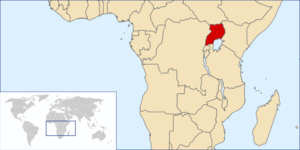Climate of Uganda
Uganda's should be a true equatorial climate that is moist and hot but it is modified by altitude. It it experiences alot ofsunshine, but the temperatures are moderated by the relatively high altitude of most areas of the country. The country's temperature experiences range between 16oC and 34oC but the situation countrywide shows great disparities. Mean annual temperatures range from about 16° C in the southwestern highlands to 25° C in the northwest; but in the northeast, the climat becomes more arid with temperaturesexceeding 30° C about 254 days per year. Daytime temperatures average about eight to ten degrees warmer than nighttime temperatures in the Lake Victoria region, and temperatures are generally about fourteen degrees lower in the southwest.
Except in the northern half of the country which is fairly dry, precipitation is well distributed. The southern region has two rainy seasons, usuallypeaking inearly April and again in October/November. Little rain falls in June and December which mark the 'dry' months, thoughstrictly speaking there is no dry month.Mean annual rainfall near Lake Victoria often exceeds 2,100 millimeters; the mountainous regions of the southeast and southwest receive more than 1,500 millimeters of rainfall yearly. In the north, the rainfall pattern is unimodal (one rainfall season) thatoccurs between April and October, while the period from November to March is often very dry. Themean annual rainfall in the arid and semi-arid northis much lower than in the wet south, andmay be as low asabout 500 millimeters, thinning out to as low as 200 in the northeastern corner. Rinfall reliability deteriorates from the Lake Victoria shores toward the north eastern part of the country and westward to just before the slopes of the southwestern highlands.
In general, the climate of Uganda is mainly influenced by:
- the dry N.E. and Northerly air masses which cause the dry weather in much of the north
- the dry South Easterlies which becomes moist after blowing over Lake Victoria thus causing the wet conditions in much of the south.
- the presence of Lake Victoria which supplies moisture that make the south moist. Were it not for Lake Victoria, Uganda would be a drier country due to continentality.
Note that in detail, just like in any other region, the micro-climatic experiencesof Uganda are more than as just simply described above due to microconditions that vary from place tho place. for instance, temperatures on mt Elgon at the eastern border with Kenya, and on the Ruwenzori mountains on the west, may fall up to sub zero while the northern arid and semi arid ares may occassionally be as warm as 40oC. Yet rainfall experiences may also vary beyond the indicated extremes.
Return to the Uganda country profile
Return to the Africa Collection
